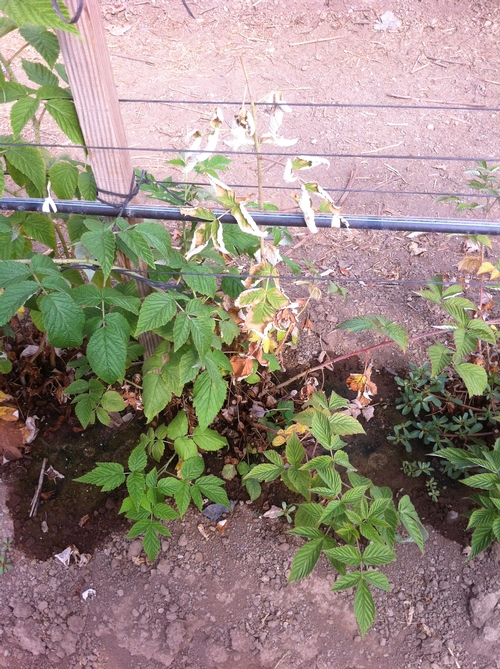While raspberry crown borer, Pennisetia marginata, is not an unusual pest in local blackberries, this is the first time we've found it in raspberry on the Central Coast for a while.
As one can see from the the first photo below, the wilt of the affected raspberry plant is quite sudden. Unlike what we find in blackberry however, the borehole in these raspberries is well below the soil line, more than a half an inch easily. Pointing to a diversity of population, some channels leading into the cane from the borehole were empty, while others had larvae and yet others had soon to eclose pupae nestled within.
There are several approaches to management of raspberry crown borer. The commonly practiced shortened production period of two years or less of raspberries on the Central Coast goes a long way to limiting the establishment and in my mind has made greatly minimized the presence of this pest in its namesake host. In short, removal of infested cane will do a lot in limiting infestations, especially if one is removing canes with late stage raspberry crown borer within.
There are also pesticides labeled for use against raspberry crown borer, and these can be effective, especially over a two year term of treatment in bringing infestations under control. Please note the restrictions and special conditions of these two:
Diazinon is registered for a drench application for raspberry crown borer, but the label restricts this application to “spring, before bud break. Potential users of Diazinon should be aware that there are water quality issues associated with this pesticide.
Admire has a label for caneberries, the only caveat would be the 7 day PHI and caution to not use it when bees are actively foraging. This is a material that is going to be traveling around actively in the plant, but one should bear in mind that applications should be made with plenty of water as the active ingredient in Admire of imidacloprid has a real affinity for soil particles and can get hung up there if there isn’t enough water behind it.
8/29/13 addition: If making the decision to use Admire, please do take note that this material should not be applied during bloom and when bees are foraging.
Thanks to the grower for having me out, I always appreciated getting these calls to come out and have a look at something new and interesting.
The above article discusses the use of several pesticides for management of raspberry crown borer in caneberries. As always, before using any of these products, check with your local Agricultural Commissioner's Office and consult product labels for current status of product registration, restrictions, and use information.
Attached Images:

Sudden wilt of raspberry cane typical of raspberry crown borer infestation.

Borehole from raspberry crown borer. Note clean edges of hole - no frass and not typical.

Top view of raspberry crown borer gallery - note discoloration and frass.

A raspberry crown borer excavated from its burrow in the cane.

Raspberry crown borer pupa removed from wilted cane. This one will eclose (meaning the adult moth with emerge) quite soon.